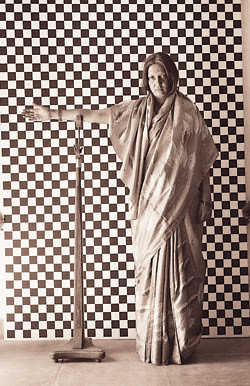PUSHPAMALA N. proves a natural to performance photography, provoking alternate ways of seeing and art-making. In her recent work, "Native Women of South India: Manners and Customs", which was on at Bangalore's Gallery Sumukha from March 7 to 27, 2004, she collaborates with photographer Clare Arni with dramatic results.
Realised through a two-year India Foundation for the Arts (IFA) grant, their unusual concept is explained thus: "Pushpamala, South Indian artist, and Clare Arni, British photographer who has lived most of her life in South India — one black, one white — play the protagonists in a project exploring the history of photography as a tool of ethnographic documentation. Playing with the notions of subject and object, the photographer and the photographed, white and black, real and fake, the baroque excess of the images subvert and overturn each other."
Sourcing data from artist friends, working with hoarding and auto-rickshaw painters, Baroda-trained Pushpamala is central to the 10 main tableaux, a nayika recreating generic stereotypes.
These encompass detailed renditions of three Ravi Varma paintings — "Lady in Moonlight", "Lakshmi" and "Returning from the Tank". That's besides a newspaper photograph of two women chain-snatchers, holding identity slates; a 1960s still of Jayalalithaa in action gear from an India Today cover; a 16th Century yogini from a Bijapur miniature, communing with her spirit medium; even a Velankanni Mary amidst the devout. The most startling renders a Toda woman against a chessboard backdrop, her arm outstretched against a measuring device — adapted from a photograph of a bare-breasted Andamanese native being subjected to colonial "ethnographic studies".
Deconstructing these "native types", the artists take off with the subversive wit so individual to Pushpamala's work. This results in a Ravi Varma heroine as a popular Amrita Sher-Gill figure. Or a gingham-clad Clare and her collaborator in sepia renditions sourced from a catalogue of oceanic photography. Or even the Toda woman astride a scooter.
En route, these conceptual artists interface with gender studies, art history, or sociology — including the women-only zenana studios of Kolkata and Hyderabad. Chuckling, Pushpamala describes the multi-layered show as "a sister act, double bill or even a dasavatar".
The 1984 National Award winner is currently preparing for a solo show of her performance photography since 1997 at New York's Bose Pacia Gallery from April 7, including "Phantom Lady or Kismet", "Dard-e-Dil", "Sunhere Sapne" and "Bombay Photo Studio". Each presents the artist in multiple roles — as an actress, as a director, and as an architect toying with memory and history.
Here are insights into "Native Women", excerpted from a recent interview
What triggered this series?
I've been doing performance photography, instead of sculpture, since the 1997 Phantom Lady series, which Clare saw in the United Kingdom. As a photojournalist, she's interested in images of South Indian women. That captured my imagination. We decided to collaborate and applied for an IFA grant for our ambitious work, a departure from the performative photo-romances or studio portraiture I'd earlier directed.
How did the collaboration work?
In my earlier performance photographs, a mise en scene was set up. Other characters and I posed, while a still photograph was taken. Both Clare and I were interested in the tableaux form.
We decided to recreate representations from different media — paintings, newspaper photographs, historical photography, advertisements, film stills, including goddesses, mythological characters and criminals. Clare insisted that each shoot should differ in terms of image, set, lighting, costume, even character.
Of course, the 1960s Jayalalithaa picture (in Zorro-style action gear) from the India Today cover connects directly with the Phantom Lady. Choosing the painterly Ravi Varma woman with the pot suited us fine because I was working with hoarding painters for the backdrops, and he's been so influential in forming the image of the Indian woman.
Finally, we decided on four series — the main images, then the ethnographic, popular, and process photographs.
Did you hit snags on the way?
After we'd shot the Bijapur yogini from a black-and-white image, Clare found from a colour picture that the folkloristic figure was blue, like Shiva or Krishna. Though the backdrop was OK, the costume was wrong. Art critic Rasna Bhushan researched similar costumes at Hyderabad's Salar Jung museum. We recreated the specifically Hyderabadi jewellery, including an unusual chest ornament. Finally, we re-shot the elaborate tableaux a month before the show.
Isn't collaboration unusual in the process of art?
Unlike naturally collaborative single-director forms like film or theatre, it's unusual for us to be co-authors. It might be even tougher for two artists, who'd bring their history as practitioners into the venture.
Why are you central to each image?
In this show of over 200 photographs, each picture extends into a narrative with different histories and image-making. There's a vamp, a rustic woman, a marginal Toda woman, a criminal woman, a mother goddess, a seductress — typical images of women as seen by the male hierarchy or patriarchy.
By enacting them, I comment on the world and society. I transform the stereotypical with my persona. When Clare's in the picture, it's our narrative.
What shaped your individual, wit-laced voice in art?
I think serious art practice is necessary to human life and expression. My work is very conceptual, but I don't want it to be dry.
I was influenced by two of India's wittiest artists, K.G. Subramanyan and Bhupen Khakkar, who gave me a language to express myself with.
This makes art accessible to the public, though there's the danger they may not take it seriously, as my expression ranges from the ridiculous to dark humour as I try to crystallise the potency of the multi-layered image.
(Native Women Of South India — Manners And Customs — a collaborative project of performance photography by Pushpamala N. and Clare Arni, 2000-2004)






No comments:
Post a Comment